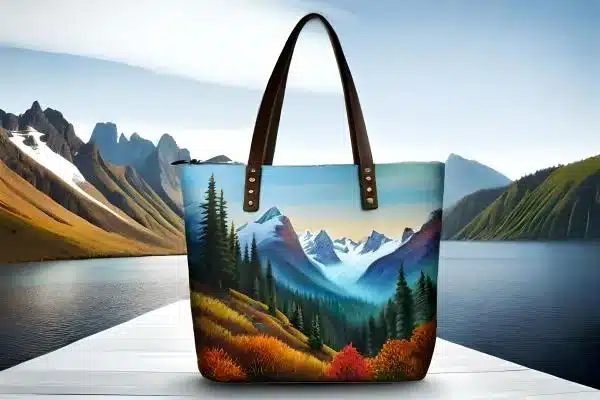Table of Contents
The History of Tote Bags
When it comes to carrying our belongings, tote bags have become an essential item in our everyday lives. From groceries to books, laptops to gym clothes, these versatile bags are designed to hold it all. But have you ever wondered about the history and evolution of tote bags? Where did they come from, and how did they become such a popular fashion accessory? In this blog post, we’ll explore the fascinating journey of tote bags and how they have evolved over time.
Origins of Tote Bags: From Functionality to Fashion

The origin of tote bags can be traced back to the early 17th century. The term “tote” actually means “to carry” and was derived from African languages. Tote bags were initially popularized by sailors who needed a durable and easily accessible bag to carry their belongings while at sea. These early tote bags were made from canvas or sturdy fabrics and had a simple design, featuring a single large compartment and sturdy handles.
However, it wasn’t until the late 19th century that tote bags started to gain popularity beyond the maritime community. In the early 1900s, L.L. Bean introduced the Boat Bag, an iconic tote bag that appealed to outdoor enthusiasts. Made from durable cotton canvas and reinforced with leather handles, these bags were designed to withstand rough conditions and carry heavy loads. The Boat Bag’s practical design and durability made it a hit among campers, hunters, and farmers.
Tote Bags Meet Fashion: The Rise of Canvas and Designer Totes

In the 1960s and 1970s, history of tote bags started to transition from a practical item to a fashion statement. This shift was largely influenced by the rise of the environmental movement and the desire for reusable, eco-friendly bags. Canvas tote bags became increasingly popular as they were not only durable but also customizable and easy to clean. People began using tote bags as a means of self-expression, decorating them with slogans, artwork, and personal touches.
During the same era, designer tote bags started emerging, creating a new market for these versatile accessories. Luxury brands like Chanel and Louis Vuitton introduced their own versions of tote bags, combining functionality with high-end aesthetics. These designer tote bags became a symbol of status and sophistication, further cementing the popularity of tote bags in the fashion world.
Evolving Designs: From Minimalistic to Versatile
As the demand for tote bags continued to grow, designers and manufacturers began experimenting with new materials and designs. No longer limited to canvas, tote bags started being made from various fabrics such as nylon, leather, and even recycled materials. This diversity allowed for a wider range of styles, catering to different tastes and needs.
In terms of design, tote bags have evolved from simple, minimalistic designs to more intricate and versatile configurations. Many modern tote bags now feature multiple compartments, zippered pockets, and adjustable straps, making them suitable for various activities and organizational preferences. Some brands have even introduced reversible tote bags, providing users with two different looks in one bag.
The Tote Bag as a Fashion Statement
Today, tote bags have become a fashion staple and are a common sight on the streets around the world. They are no longer reserved for practical purposes but have become an integral part of our personal style. With countless color options, patterns, and designs, tote bags allow individuals to express their uniqueness and personality.
Moreover, tote bags have also become a canvas for promoting social causes and raising awareness. Many brands and organizations now use tote bags as a way to support environmental sustainability, community initiatives, and other charitable causes. By using a tote bag, individuals can not only make a fashion statement but also contribute to a larger societal impact.
The Future of Tote Bags: Innovation and Sustainability
As we look ahead, the future of tote bags seems bright. With innovations in materials and manufacturing processes, tote bags are becoming even more sustainable and eco-friendly. Brands are increasingly using recycled fabrics and biodegradable materials to produce tote bags, reducing their carbon footprint and environmental impact.
Additionally, advancements in technology have allowed for the integration of smart features into tote bags. Some bags now come equipped with built-in charging ports for smartphones or RFID-blocking pockets for added security. These innovations make tote bags not only fashionable but also functional tools for the modern-day individual.
Frequently Asked Questions (FAQs)
When were tote bags invented?
Tote bags have been around for centuries, but the modern tote bag design was popularized in the early 20th century.
Who invented the tote bag?
The exact inventor of the tote bag is unclear, but the design became prominent in the 1940s with the introduction of the “ice bag” by L.L. Bean.
What was the original purpose of tote bags?
The original purpose of tote bags was to carry ice, groceries, and other goods. They were popular among outdoor enthusiasts, sailors, and shoppers.
When did tote bags become popular for everyday use?
Tote bags gained popularity for everyday use in the 1960s and 1970s when they became associated with the fashion and culture of the time.
How did tote bags become a fashion accessory?
Tote bags transitioned into a fashion accessory in the 1960s when designers and artists started using them as a canvas for their creative designs.
What materials were early tote bags made from?
Early tote bags were made from durable materials like canvas and cotton, which allowed them to carry heavy loads without tearing.
How did tote bags become eco-friendly?
Tote bags gained eco-friendly status in the late 20th century due to the rise of environmental awareness. Reusable tote bags became a sustainable alternative to single-use plastic bags.
When did tote bags start featuring logos and branding?
Tote bags with logos and branding became popular in the 1980s and 1990s when businesses and organizations used them as promotional items.
Are tote bags still popular today?
Yes, tote bags remain popular today for their versatility, sustainability, and ability to serve as a blank canvas for artistic expression.
What are some modern uses of tote bags?
Modern uses of tote bags include grocery shopping, carrying books, as gym bags, for travel, and as stylish fashion accessories.
How has the design of tote bags evolved over time?
The design of tote bags has evolved to include various sizes, shapes, materials, and features, catering to different preferences and needs.
Are there any iconic or famous tote bag designs in history?
Yes, certain tote bag designs have gained iconic status, such as the L.L. Bean Boat and Tote Bag and the “I ♥ NY” logo tote bag.
Do tote bags have cultural significance?
Yes, tote bags have cultural significance in various contexts, representing environmental awareness, fashion trends, and individual expressions of style.
Are vintage tote bags collectible items?
Yes, vintage tote bags, especially those with unique designs or historical significance, can be collectible items sought after by enthusiasts and collectors.
In Conclusion
From their humble beginnings as sailor’s bags to fashion-forward accessories, tote bags have come a long way. Their evolution from simple functionality to stylish fashion statements reflects the changing needs and preferences of individuals around the world. As we continue on this journey, the future of tote bags looks promising, with an emphasis on sustainability, innovation, and personal expression.
So the next time you grab your trusty tote bag before heading out the door, remember the rich history and evolution that this everyday item carries. It’s not just a bag; it’s a symbol of versatility, practicality, and a reflection of your unique style.